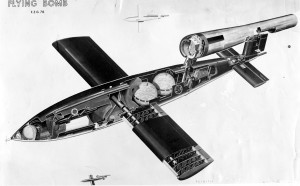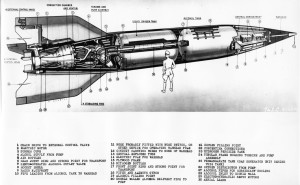SciTech Tuesday–First V-1 rockets launched June 1944
On June 13th 1944, the Germans launched the first attack of V-1 rockets on England. The rockets were really pilotless planes that depended upon compasses and gyroscopes for navigation. Detonation was achieved when the engine ran out of fuel and the vehicle crash landed. Of the rockets launched in this initial raid, five crashed near the launch site on the coastt of France, and 4 landed in England. One of the latter landed in London and killed 6 people.
The launch of these V-1 rockets was timed to match a large conventional bombing raid, but the Royal Air Force had successfully targeted the bombers on the runway the day before.
But over the next couple of weeks almost 3000 V-1s were launched against England. Many were brought down over the English Channel by fighters or anti-aircraft guns. About 800 missiles hit greater London in those early summer weeks.
In September the first V-2 rocket attacks were launched, simultaneously with V-1s. About 9000 V-2s were launched against England, killing about 2500 Londoners.
The full name of the V-1 was the Vergeltungswaffen 1. Vergeltungswaffen roughly translates as “retaliatory weapon.” They were launched after the Allied invasions on D-Day, and were also used against Belgium. The launches of V rockets continued until the launch center was over-taken by Allied forces in March 1945.
The V-1 had a fuselage of steel and wings of plywood. It was propelled by a pulsejet engine that fired 50 times per second—giving it the characteristic sound that got it the nicknames ‘doodle bug’ and ‘buzz bomb.’ The gasoline jet engine didn’t provide enough force for takeoff, so the missile was launched with a chemical explosive that got it’s speed up over 350 mph. The V-1’s mechanically complex guidance system led to its low success rate of 25%. They were, however, relatively easy and cheap to manufacture, and caused the Allies to spend a great deal of time and resources to defend against them.
The V-2 used a liquid propellent system of ethanol/water and liquid oxygen. This was a much more powerful system that allowed the missile to travel further and actually cross the boundary of space. The rocket propelled the missile up at an angle for about 65 seconds, after which it sut off and the rocket travelled under the power of gravity. The earlier V-2s used an analog computer to calculate when to shut the engine off. Later models used a radar controlled switch, so that they could be controlled from the ground.
Post by Rob Wallace, STEM Education Coordinator






Leave a Reply